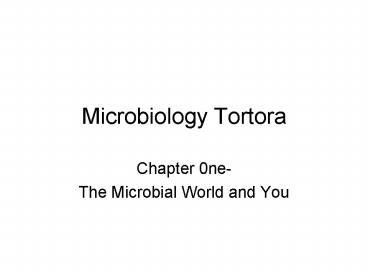Microbiology Tortora - PowerPoint PPT Presentation
1 / 14
Title:
Microbiology Tortora
Description:
Microbiology Tortora. Chapter 0ne- The Microbial World and You ... microbiology ... Golden age of microbiology-began with Pasteur's work. Germ theory of disease ... – PowerPoint PPT presentation
Number of Views:4540
Avg rating:3.0/5.0
Title: Microbiology Tortora
1
Microbiology Tortora
- Chapter 0ne-
- The Microbial World and You
2
Some Little Bug
- In these days of Indigestion
- It is often times a question as to what to eat
and what to leave alone - For each microbe and bacillus has a different
way to kill us, - And in time they always claim us for their own.
- There are germs of every kind in any food that
you can find - In the market or upon the bill of fare.
- Drinking waters just as risky as the so-called
deadly whisky, - And its often a mistake to breathe the air
- By Roy Atwell
3
Microbes in our lives
- Microorganisms or microbes are too small to be
seen with the naked eye - Includes fungi, bacteria, yeasts and molds,
protozoa, and microscopic algae - May cause disease (pathogens) (http//www.cdc.gov
/ncidod/dhqp/bp.html) - or food spoilage http//www.foodservice.com/food_s
afety/fb6.cfm - BUT are also beneficial (photosynthesis, food
production, recombinant technology, waste
treatment, etc) http//www.safe-food.org/-issue/ge
.html
4
Naming organisms
- Binomial nomenclature was created by Carolus
(Karl) Linnaeus - 2 name naming (genus and species)
- Use Latin
- Genus is capitalized (Streptococcus)
- Species is small case (aureus)
- Always use italics or underline
5
Types of microorganisms
- Bacteria (singular is bacterium)-simple,
unicellular organisms that DONT have a nucleus
around the genetic material (prokaryotic-before a
nucleus) - 3 main shapes are bacillus (rodlike), coccus
(oval or round), and spiral (corkscrew shaped) - Usually reproduce by binary fission
6
Other types
- Archaea-found in extreme environments and include
methanogens, extreme halophiles, and extreme
thermophiles - Fungi-are eukaryotes because they have a true
nucleus - May be yeasts, molds, mushrooms
- True fungi have chitin in cell wall
- May be asexual or sexual
7
Still more types
- Protozoa-unicellular, eukaryotic microbes that
move by pseudopods, flagella, or cilia - Algae-photosynthetic eukaryotes that play
important role in balance of nature - Many algae have cellulose in cell wall
- Parasites-multicellular-include flatworms and
roundworms - Viruses are very small (measured in nanometers),
have only DNA or RNA surrounded by a protein coat
(usually)
8
History of microbiology
- http//users.stlcc.edu/kkiser/History.page.html
this site has a time line and pictures of the
major players in early microbiology (go there to
study!!) - Cell theory-Hookes discovery marked the
beginning of this - Spontaneous generation-life from non-life
- Much early micro work was to either prove or
disprove this theory - Biogenesis-living cells come from pre-existing
cells - Aseptic technique-germ free
- Golden age of microbiology-began with Pasteurs
work - Germ theory of disease-proved by Koch
9
Modern Chemotherapy
- Treatment of disease using chemical substances
- Synthetic versus antibiotic
- Paul Ehrlich-magic bullet-salvarsan- salvation
from syphilis (1910) - Alexander Fleming-accidentally discovered
penicillin in 1928
10
Modern Developments
- Bacteriology-study of bacteria, began with
Leeuwenhoeks examination of tooth scrapings - Mycology-study of fungi
- Parasitology-study of protozoa and parasitic
worms - Immunology-study of the immune system, began with
Jenners first vaccine in 1796 - Advanced when Rebecca Lancefield classified
Streptococcus based on differences in cell wall
11
Modern Developments continued
- Virology- Iwanowski and the tobacco mosaic virus
discovery in 1892 gave it a major boost - Recombinant DNA technology-use microorganisms to
manufacture human hormones and other medical
substances (growth hormone used to come from
cadavers) - The technology is also called genetic engineering
- 1944 DNA proved to be unit of heredity (Averys
group - 1946 Lederberg and Tatum discovered conjugation
- 1953 Watson and Crick created model for DNA
- 1961 Jacob and Monod discovered mRNA leading to
the understanding of protein synthesis
12
Microbes and Humans
- Recycling vital elements-nitrogen is common but
must be changed into a usable form by bacteria to
be available for plants and animals - Sewage treatment-Zooglea help break down
particulate matter in sewage treatment - Bioremediation-using bacteria to clean up toxic
spills - Insect pest control -Bacillus thuringensis is
toxic to the digestive tract of bollworms, corn
borers, tomato worms, etc.
13
Microbes and Humans continued
- Biotechnology has now allowed gene
therapy-inserting a missing gene into human cells - Normal flora-populations of bacteria in and on
you that help keep you healthy by providing
vitamins, prevent overgrowth of harmful
pathogens, etc
14
Disease
- Infectious disease-when pathogen invades a
susceptible host - Emerging infectious disease-new diseases that
have appeared in the last couple of decades - EIDs include Avian influenza (bird flu), SARS,
West Nile Virus, BSE or mad cow disease, CJD is
human disease like mad cow, E-coli 0157H7,
flesh-eating disease caused by IGAS or invasive
group A Streptococcus, Ebola, AIDS and HIV, and
cryptosporidiosis































